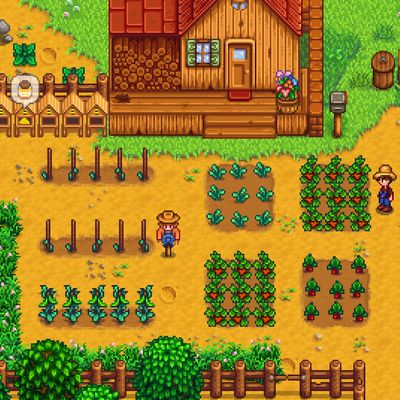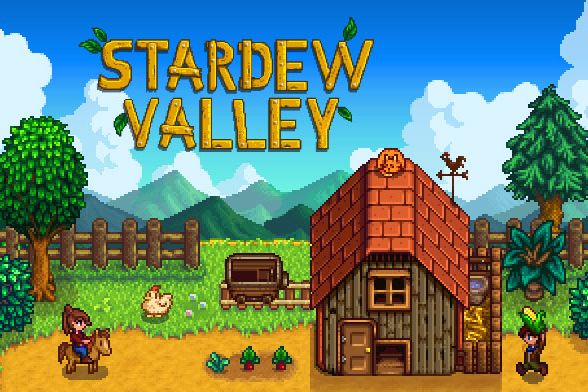
If you check out the list of top-selling titles on Steam, the online game-distribution juggernaut, one game sticks out. Whereas the rest of the list is populated mostly with the most recent entries in the long-running, big-studio Hitman and GTA and Tom Clancy franchises, sitting inexplicably in the #2 spot is Stardew Valley, a game with pixelated SNES-style graphics, a meandering pace, and the simple core mechanics of planting and watering and cultivating different crops over and over and over as the days and seasons pass. It does not sound like a blockbuster. And yet it is — more than 550,000 people have downloaded it in the two and a half weeks since it was released.
The premise is simple: You’re a young-professional-type who leaves your soulless corporate job to take over your grandfather’s dilapidated farm, starting from scratch. The goal is, in a sense, whatever you want it to be: Stardew Valley floods the players’ stimulus-reward system with a never-ending series of short-term goals as day bleeds into day, season into season. In addition to raising crops (which must be watered every day), you can learn to fish, extract ore from a mine that runs dozens of levels deep, talk to and romance townspeople, and on and on.
If this mostly sounds more like drudgery than play — a simulation of waking up early to water melons? — that’s because the appeal of Stardew Valley is very hard to explain. It’s one of those titles that looks underwhelming at first blush, but then makes quick converts of those who click “download.” It’s an insanely addictive, mesmerizing game — I lost about eight unplanned hours to it during an otherwise busy weekend. There are different strategies during each of the four seasons, a zillion options for laying out your farm and choosing which animals and crops to raise, and so on; the depth and variety is astounding.
Stardew Valley would be an impressive accomplishment for a seasoned game-development studio. What makes it especially remarkable, then, is that it was produced by a single developer who had never before made a commercial game: Eric Barone, a 28-year-old Seattleite who is better known by his ConcernedApe handle on Twitter and Reddit.

As Barone explained to Vulture, he graduated from the University of Washington–Tacoma with a computer-science degree in 2011, and did what you’re supposed to do: He applied for entry-level coding jobs. None of the prospective employers bit, though, and Barone wasn’t particularly enthused about the prospect of working in a cubicle anyway, so he decided to try to make a game instead. His original ambitions were modest: He had always been a fan of the Harvest Moon farming-simulator games — a classic series dating back to the 1990s with a cult-like following — and decided to make a clone of sorts.
“I just wanted to release it on XBox Live Indie Games, which is kind of a free-for-all,” he said. He figured fans of the original series would play, and it could serve as a sort of proof-of-concept of his own game-design skills. That limited vision didn’t last long, though. “As I started to work on the game and my development skills improved, I started seeing all the possibilities,” he said. “At some point I realized this could be legit. I could become a real indie game developer. So I went for it, redoing stuff, making it better.”
For four years, he says, he worked an average of ten hours a day, seven days a week, on Stardew Valley. Luckily, he was living with his girlfriend, a graduate student in, appropriately, plant biology, and to help stay afloat he worked part-time as an usher at Seattle’s Paramount Theatre. As Barone toiled, he did so in the hopes of recapturing something that, in his eyes, had been missing from the most recent entries in the Harvest Moon series.
“They lost touch with that magic that made the first few titles special,” he said. “They had created these rich and special worlds that you could get lost in. The gameplay was very simple, but there was something kind of addictive about it: You wake up every morning, you check your farm, and you’re excited by the simple beauty of your crops going from seed to harvestable product. There was something about that relaxed gameplay in this immersive, beautiful world that felt really special. It was touching in a certain way.”
Usually, the concept of “immersion” brings to mind epic games like the GTA or Morrowind series. They’re immersive because your character is small and the world is large. Neither the Harvest Moon games nor Stardew Valley are particularly big, geographically, so the sense of immersion feels different, and needs to be approached differently as a developer. A sense of depth is accomplished in part by lavishing the game with visual richness. “There are critters that run around, and when you cut the grass a frog jumps out,” explains Barone. “There are all these little instances of attention to detail.”
But more important are the game’s characters: Stardew Valley features a variety of villagers, from the mayor to a bum living in a tent at the edge of town. Many of them have touching story lines that are only accessible if you take the effort to give them gifts and listen to what they have to say. Notes Barone, “They all have fully fleshed-out lives and schedules that they go about every day.”
The job your own character quits at the beginning of the game is with the Joja Corporation — a stand-in for [insert hated corporate behemoth]. But when you get to Stardew Valley you find out that, as the game’s promotional material puts it, “Ever since Joja Corporation came to town, the old ways of life have all but disappeared.” At the edge of town sits the JojaMart, a superstore that offers you cheap goods in a familiarly sterile setting — but only if you become a member, which could have negative consequences for the town. “I want Stardew to be a fun game, but I also wanted to have real-world messages,” said Barone.
One of the messages in Stardew Village, then, is to chill out a little, to not get sucked into the capitalist vortex. While most Harvest Moon games, Barone said, end after two in-game years of farming, he designed Stardew Valley so people could play as long as they want (one beta tester, he said, is five or six years — about 400 real-world hours — into running her farm). That allowed him to throw a boatload of options, plot lines, and goals at players without them feeling like they’ll be missing out by zigging instead of zagging. “I wanted it to feel overwhelming with stuff to do, yet you didn’t feel stressed about it,” he said. “More just excited that you’ve got things to do.”

That doesn’t mean every player is going to adhere to that meandering approach. As soon as Stardew Valley was released, players began creating and publishing complex spreadsheets and guides designed to help make as much gold as possible — to effectively turn their land into, well, a kind of profit-maximizing Joja Farm. Barone acknowledged the inevitability of some Type-A players taking this tack, but believes it’s not quite in the spirit of the game.
“I’m not a parent, but I imagine that this is kind of what it feels like to raise a child,” he said. “During their adolescence you’re their whole world, basically, and then suddenly they move out and they’re on their own, and you realize that maybe they’re not even the person you thought they were. I still think that the best way to play the game is to figure everything out yourself and not necessarily try to maximize the amount of money you make in anything, but I can understand that eventually you would want to do that just as a way of challenging yourself within the game.”
Still, during the development process Barone made plenty of decisions that were more about attaining the feel he wanted for the game than maximizing player freedom or fun. Butchering, for example. Being a farming simulator, Stardew Valley allows you to buy and raise animals which then produce resources for you — chickens produce eggs, cows produce milk, and so on. Beta testers had asked Barone to include a feature that enabled users to butcher their animals and harvest the meat, and he listened to them at first, but in the end he couldn’t bring himself to include the mechanic. “I didn’t want to have that sort of violence. You give the animals names, pet them, and a little heart goes above their head and stuff, and then you butcher them?” he said. “It just felt wrong. It didn’t jibe with the feeling I was going for with the game, so I cut that, and I don’t regret it.” (Unsurprisingly, Barone is a vegetarian.)
Barone also made a subtle yet telling design decision about the game’s cooking mechanic: Once you purchase a kitchen and recipes, Stardew Valley allows you to combine items into meals. In the simplest recipe, you turn an egg into a fried egg. But Barone specifically set things up so that selling a dish you cooked wouldn’t yield more gold than selling the individual ingredients. “I did that intentionally because it’s not fun to turn all your eggs into fried eggs,” he said. “There is value to making fried eggs — it heals more of your energy when you eat it — so there’s a point to cooking. But it’s not to make as much money as possible, because then you’ll feel like you have to turn every single ingredient into cooking, which is just more clicking.”
In other words, cooking exists to provide players with health and energy — to encourage them to indulge in the core mechanics of farming, mining, and fishing. He didn’t want the kitchen to be a click-click-click profit-maximizing feature. Both decisions align with Barone’s vision for the sort of behavior games should encourage: not mindless clicking and maximum efficiency, but something more thoughtful and slower-paced and conducive to wonder. And when you’re a one-man team, you get to make whatever decisions you want. A game like Stardew Valley, Barone said, is “a lot more personal than a game made by a hundred people that’s some kind of focus-tested experience where they just want to make as much profit as possible.”
But as things turned out, profit wasn’t a problem. After Stardew Valley dropped on February 26, Barone watched in awe as the sales numbers rushed skyward. Thanks in part to the fact that Barone’s publisher, Chucklefish, had aggressively marketed the game to popular Twitch and YouTube personalities who streamed early builds, Stardew Valley was on a lot of radars, and both sales and plaudits quickly began rolling in. Even taking out Chucklefish’s cut and whatever special offers have helped build momentum, 550,000 units sold at $15 a pop means Barone has earned a generous retroactive salary for the last four years and ensured himself a future as an independent game developer.
All that said, Barone says the full weight of success hasn’t hit him yet. He’s still putting in long hours refining the game, and responding tirelessly to fans’ requests and feedback and bug reports — only now he’s been rewarded for his attentiveness. And despite how demanding the creation of Stardew Valley was and still is, Barone’s already thinking about what’s next. “I want to create a collection of games during my career,” he said, “so that when I’m on my deathbed I can look back and see that I created all these wonderful things that brought people joy.” And if that joy comes from making stacks of in-game money, well, so it goes.




